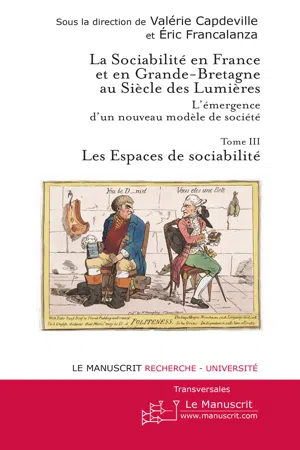
La sociabilité en France et en Grande-Bretagne au siècle des Lumières. Tome III
Les espaces de sociabilité
- French
- ePUB (adapté aux mobiles)
- Disponible sur iOS et Android
La sociabilité en France et en Grande-Bretagne au siècle des Lumières. Tome III
Les espaces de sociabilité
À propos de ce livre
Ce volume de Transversales constitue le troisième volet des travaux de spécialistes internationaux des études sur le dix-huitième siècle français et britannique. Dans le cadre d'un projet de la Maison des Sciences Humaines de Bretagne (MSHB), « La sociabilité en France et en Grande-Bretagne au siècle des Lumières: l'émergence d'un nouveau modèle de société », ces chercheurs tentent de redéfinir les modes opératoires de la sociabilité pour chacune des deux nations, à partir de sources célèbres ou méconnues, et s'interrogent sur la réalité de la supériorité du modèle français de sociabilité. La notion d'espace, dans ses acceptions diverses, sert de trame théorique à ce recueil dans lequel les espaces de sociabilité sont envisagés selon plusieurs angles d'analyse.This volume is the third in the Transversales series published by a group of researchers of different nationalities, with the support of the Maison des Sciences Humaines de Bretagne (MSHB), on the topic of sociability in France and Britain during the Enlightenment. The research is focusing on the extent to which a new model of sociability emerged in these nations during that period, and the similarities and differences in the ways this model developed on each side of the Channel. The study of both famous and unknown sources may eventually question the superiority of the French model of sociability. The concept of space, in its various dimensions, is taken as the framework for the analysis of sociable spaces from different perspectives.The Transversales Series Editor is Annick Cossic-Péricarpin.
Foire aux questions
Informations
Big City, Bright Lights ?
Night Spaces in Paris and London, 1660-1820122
University of Southampton, UK
Table des matières
- Présentation de la collection
- Comité Scientifique
- Les auteurs
- Introduction Les espaces de sociabilité
- Première partie Lieux et formes de sociabilité
- Cafés et coffeehouses. Pour une histoire transnationale des cafés comme lieux de sociabilité
- London Clubs or the Invention of a ‘Home-made’ Sociability
- Big City, Bright Lights ? Night Spaces in Paris and London, 1660-1820
- Les loisirs urbains à Paris et à Londres au XVIIIe siècle : civilité, politeness et la construction sociale des comportements
- ‘Plaire en instruisant’ :Learning Manners and Politeness in Eighteenth-Century England and France
- Deuxième partie Cercles et vecteurs de sociabilité
- Un réseau de sociabilité et d’information au siècle des Lumières : la chambre de lecture
- La sociabilité dans les cercles huguenots d’Angleterre au XVIIIe siècle
- Mise en scène du foyer : sociabilité de la réussite chez les négociants rochelais
- Entre amitié et vertu : sociabilités de Schoppenwihr à Vizille au tournant de la période contemporaine
- Conclusion Des espaces de la sociabilité en France et en Grande-Bretagne au XVIIIe siècle ou les leçons d’une géométrie dans l’espace